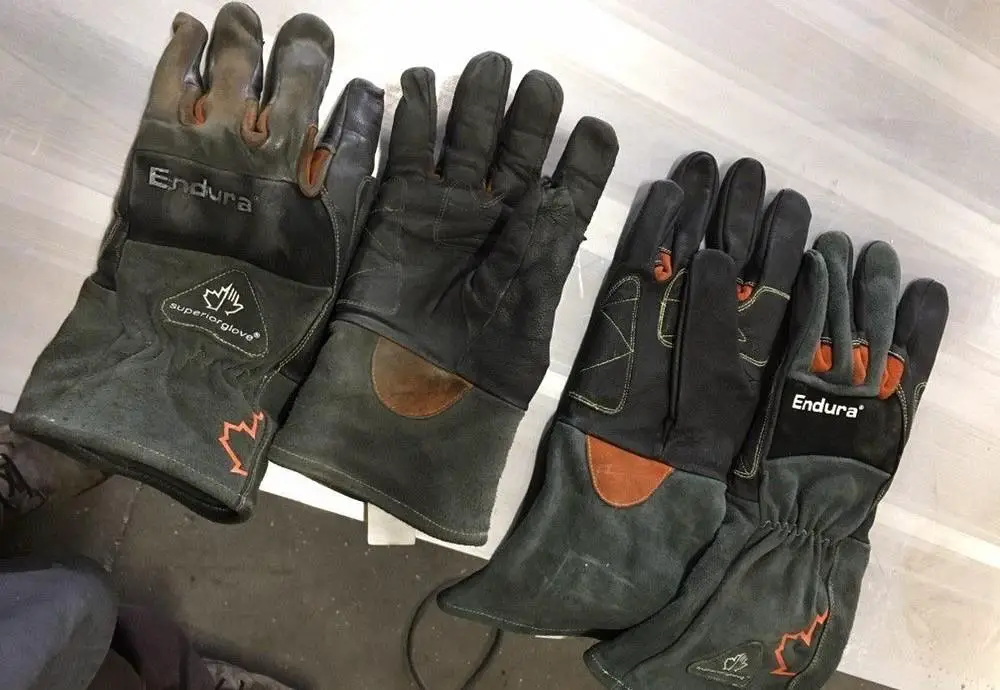Safety at hazardous workplaces like a welding site, construction site, heavy machinery site, etc., require employees to wear protective clothing and gear to avoid injuries caused by unfortunate accidents when working.
No matter how cautious you are when working, accidents can occur anytime for no fault of yours. In this article, we are mainly talking about protective clothing for welders, and more specifically welding gloves.
While a welder needs to be wearing welding gloves when working, it is equally vital for the worker to take care of those gloves in the right way. If you do not keep your welding gloves in good condition, chances are they will wear out much sooner than they should.
A good pair of welding gloves will normally be made of leather as they have natural heat-resisting properties. Apart from keeping them clean after every use, it is necessary to condition them as well to maintain their suppleness, smoothness, and increase their lifespan.
The best way to condition welding gloves is by using or applying leather-specific conditioners post washing and cleaning them.
Read on further to find out more about welding gloves and how to take proper care of them, so they serve their purpose of keeping you safe at work for a long period of time.
What material is used to make welding gloves?
Welding gloves are an essential part of the PPE kit for welders, knowing what material is used for making them is important too.
Most welding gloves are made of leather as it is considered to be one of the best for welding work due to their ability to resist abrasions, heat, and ignition.
Even when it comes to the leather used for constructing welding gloves, it is very specific to the hide of a cow, deer, pig, or goat. These are further divided into Split leather, and Top Grain leather.
The former is thick, flexible, resistant to water and punctures. Whereas, the latter is more gorgeous to look at making it more expensive. However, compared to split leather its durability is less.
Although the most popular and good welding gloves are made from leather, you can also find welding gloves made from Kevlar which is a synthetic material but very effective. It is highly durable and can withstand a great amount of heat.
However, they can turn out to be more expensive than leather welding gloves. Kevlar is also used as only the lining of a leather glove to give you additional protection from the heat while welding.
Other types of welding glove material include rubber, cotton, and aluminum galvanized gloves.
Factors to consider before cleaning your welding gloves
Before you begin cleaning your welding gloves, there are a couple of factors that you should consider.
First and foremost, you need to know what material your gloves are made of so you do not ruin them by using the wrong method of cleaning.
There will be a manufacturer’s label in the gloves that will specify its material. If you have TIG welding gloves, then you can expect them to be made of goat, pig, or cowhide.
Whereas, MIG welding gloves will be made from either cow, pig, or deer hide. Finally, for Stick welding gloves, the hide used is that of a cow, elk, or deer.
Secondly, the manufacturer’s care instructions mentioned on the glove label need to be followed religiously.
Check the label thoroughly to understand its care tips. Not doing so can wreck it is flame-resistant properties and other such important features, which will eventually make your welding gloves useless.
Steps on Cleaning and Caring for Your Welding Gloves
We have now come to the part of the article where I have explained the cleaning and caring process for your welding gloves in detail. Please read carefully.
Step 1. Considering that welding work involves a lot of physical labor and working with all kinds of tools, chemicals, raw materials, etc.
It is quite natural for the gloves to get some or a lot of noticeable debris on them. The wise thing to do would be to get rid of such dirt first with either a dry cloth, toothbrush, or any kind of brush with soft bristles.
Brush them off from the gloves rigorously. We call this rough cleaning. This can be done while wearing the gloves or removing them, either way, works fine.
Similarly, if your gloves have any oil on them, you should use an oil eater product that is specifically meant to remove such oil remains from welding gloves.
Step 2. The second step would be to wash them in cold water, along with some saddle soap. This helps get rid of the more stubborn debris or dirt from the gloves.
Make a good lather with the saddle soap and wash the gloves thoroughly under the running cold water. You can leave the soap on for about 45 seconds or so on areas where the dirt refuses to disappear, before rinsing it off with water.
Do not use any other soap other than saddle soap or a PH-neutral soap for this step, as using the wrong kind of soap will remove the natural oil from the leather.
Step 3. After this step you need to get rid of the excess and dirty water from the gloves. Wipe off the gloves with a clean damp cloth.
Step 4. Now, rinse the leather gloves in cold water again one last time to make sure all the dirt is completely gone. Never use warm or hot water because it may affect the fit of your gloves.
Step 5. Additionally you can make a solution out of white vinegar and water to clean the interiors of your welding gloves. Simply spray it on the inside without soaking them fully with the solution. This helps get rid of any odor left behind due to sweaty hands.
Step 6. It is now time to leave your gloves to dry naturally. Massaging them gently will help avoid the stiffening of the gloves. Do not expose them to direct sunlight or use any drying appliance to expedite the drying process.
This will definitely ruin the gloves. You can even wear your gloves while they dry in your hands in order to retain their shape.
Step 7. The final step would be to apply some leather conditioner on your welding gloves to maintain their suppleness and smoothness. There are many different brands making leather conditioners so this will not be difficult to find.
Step 8. In order to be 100% sure and safe, you should wash your hands properly with soap after you are done cleaning your gloves. There is a possibility that some of the chemicals and debris from your dirty gloves are left behind on your hands, which can cause irritation to your skin.
The above steps are more applicable when cleaning leather welding gloves. If you have Kevlar welding gloves you can clean them with regular detergent and warm water as it does not affect this material. They can be even washed in a washing machine and dried in a dryer afterward in low heat.
Why is it Important to Keep Your Welding Gloves Clean?
Here are a few important points on why it is necessary to keep your welding gloves clean at all times.
1.) The protective properties or features of your welding gloves can be compromised when left dirty.
2.) If you leave your welding gloves dirty, then there is a chance of all the contaminants building up further which can result in your gloves wearing out quicker than you would like.
3.) Clean welding gloves mean an extended lifespan or their durability is maintained.
4.) Bacteria can form inside the gloves if they are not cleaned regularly after each use, which can cause skin infection.
5.) The material may become very tough and the agility of the gloves can be impacted if not cleaned. This will hamper your performance at work.
6.) The safety of the work environment can be maintained with the clean personal protective equipment of each worker.
Wrapping Up
All in all no matter what material your welding gloves are made of, at the end of the day, keeping your work gear clean is good hygiene. It will only add to your own safety and better health, so your performance at work is not hampered.
The important point here is to make sure you are aware of the kind of gloves you own before jumping into cleaning and caring for them.







